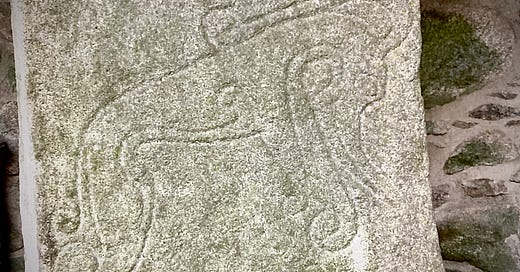The Pictish Beast
Ancient and mysterious stone carvings rise from the landscape of ancient Aberdeenshire, even when you can't actually see them.
Above the roaming rooks and the rush of the river Don as it loops around Dyce, the neverending rumble of aircraft sounds like curling stones on ice. The airport is loud in its landscape, and the landing lights are arranged like fences on a racecourse for a mile or more before the runway. The northeast of Scotland is an unknown landscape to me, and I find it far easier to make my way to Birmingham or Leeds than Aberdeen. They speak funny up there, and while it’s been easy to love butteries and smoked fish, the heart of that place is unfathomable - and in the abandoned ruins of St Fergus’ Kirk at Dyce, the sourcecode for some of that strangeness is written into slabs of ancient stone.
There are Pictish carvings throughout Aberdeenshire and into Moray, and they’re unlike anything I’ve ever seen before. I hardly even knew the meaning of the word “Pict” until I visited this place; it seemed to come from far away, and at a period of history when my Scotland was Brittonic, the Highlands were far advanced on their own unusual journey. It follows that the few surviving relics of Pictish culture strike a southerner like me as extraordinary, and the idea that Scotland’s story can be expressed as a single strand of history is blown to shreds.
At Dyce, there’s a large carved cross on display beneath a wooden awning in the shell of the old kirk. It’s unlike other crosses I’ve seen, but it’s fair to say that every ancient cross is different in its way – and some of the stonework I’ve seen in Clare and Offaly were downright bizarre. But beneath and beside this carving, there were other entirely abstract designs – elaborate zigzags overlaid upon complex knotwork; crescents encompassing arrows near patterns of concentric rings like owl eyes which loop round and back and forth upon each other. Nearby, another stone showed a creature bending forward on stiffly swirling legs – it had a long, bird-like beak and tendrils which trailed back around its shoulders to end in a spiral loop. It was no real animal; it was something mesmeric and confusing – a midpoint between a bird, a fish and a dog.
Keep reading with a 7-day free trial
Subscribe to And the Yellow Ale to keep reading this post and get 7 days of free access to the full post archives.




